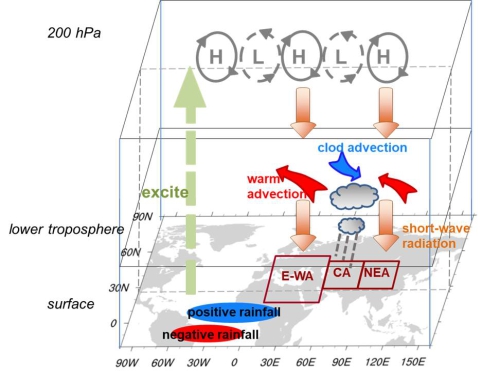
The positive-phase of Atlantic Multidecadal Oscillation (AMO) can indeed cause Eurasian summer nonuniform warming, according to Prof. LI Shuanglin, Dean of Atmospheric Science at the University of Geosciences (Wuhan) and Executive Vice-Director at the Climate Change Research Center, Institute of Atmospheric Physics, and one of the authors of a recently published study in Advances of Atmospheric Sciences.
"Previous studies indicate the Eurasian nonuniform since the mid-1990s may be related with the phase shift of AMO, and we validate this point by using ensemble experiments with three AGCMs [atmospheric general circulation models]," said Dr. SUN Xueqian, lead author of the study. "The overall consistency among the three AGCMs illustrates the robustness of AMO's influence, although the models are not the most recently updated versions."
Dr. SUN and her collaborators diagnosed the underlying mechanism of AMO's influence on the Eurasian nonuniform warming from the perspective that the boundary forcing modulated the intrinsic atmospheric variability. The results highlighted the role of the Silk Road Pattern.

Schematic diagram illustrating the mechanism of the AMO affecting the Eurasian surface temperature. E-WA, CA and NEA are short for Europe-West Asia, Central Asia and Northeast Asia, respectively. H represents "positive geopotential height anomaly" and L represents "negative geopotential height anomaly". (Image by SUN Xueqian)
"The AMO-related tropical diabatic heating anomaly excites the Silk Road wave-train over Eurasia with positive geopotential height and anticyclonic circulation anomalies over Europe-West Asia and Northeast Asia, but negative geopotential height and cyclonic circulation over Central Asia. Such opposite circulations lead to opposite changes in temperature advection, precipitation, cloud cover and solar radiation. When these effects overlap the signals of global warming, it causes amplified warming," Dr. Sun explained.
"This work did not consider the effects of the negative phase of AMO. Future work may be needed to find out whether symmetric, inverted nonuniform surface air temperature anomalies will be obtained for the cold period of AMO," Prof. LI added.

86-10-68597521 (day)
86-10-68597289 (night)

52 Sanlihe Rd., Xicheng District,
Beijing, China (100864)

